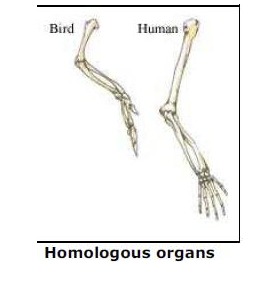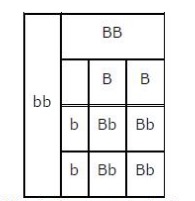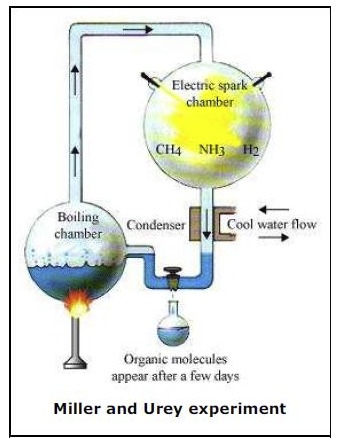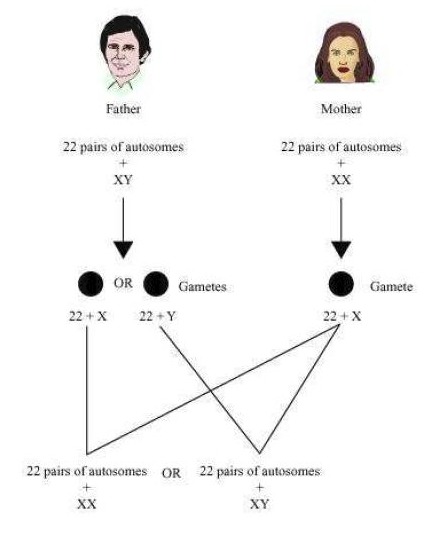Q.1: A Mendelian experiment consisted of breeding tall pea plants bearing violet flowers with short pea plants bearing white flowers. The progeny all bore violet flowers, but almost half of them were short. This suggests that the genetic make-up of the tall parent can be depicted as
(a) TTWW
(b) TTww
(c) TtWW
(d) TtWw
Ans : (c) The genetic make-up of the tall parent can be depicted as TtWW Since all the progeny bore violet flowers, it means that the tall plant having violet flowers has WW genotype for violet flower colour. Since the progeny is both tall and short, the parent plant was not a pure tall plant. Its genotype must be Tt. Therefore, the cross involved in the given question is
TtWw x ttwW -> TtWw - ttvw
Therefore, half the progeny is tall, but all of them have violet flowers.
Q.2: An example of homologous organs is
(a) our arm and a dog’s fore-leg.
(b) our teeth and an elephant’s tusks.
(c) potato and runners of grass.
d) all of the above.
Ans : (b) An example of homologous organs is our teeth and an elephant's tusks
Q.3: In evolutionary terms, we have more in common with
(a) a Chinese school-boy.
(b) a chimpanzee.
(c) a spider.
(d) a bacterium.
Ans : (a) In evolutionary terms, we have more in common with a Chinese school boy.
Q.4: A study found that children with light-coloured eyes are likely to have parents with light-coloured eyes. On this basis, can we say anything about whether the light eye colour trait is dominant or recessive? Why or why not?
Ans : Let us assume that children with light-coloured eyes can either have LL or Ll or II genotype. If the children have LL genotype, then their parents will also be of LL genotype.
LL x LL -> LL
If the children with light-coloured eyes have II genotype, then their parents will also have II
genotype.
II x II -> II
Therefore, it cannot be concluded whether light eye colour is dominant or recessive.
Q.5: How are the areas of study – evolution and classification – interlinked?
Ans : Classification involves grouping of organism into a formal system based on similarities in internal and external structure or evolutionary history.
Two species are more closely related if they have more characteristics in common. And if two species are more closely related, then it means they have a more recent ancestor.
For example, in a family, a brother and sister are closely related and they have a recent common ancestor i.e., their parents. A brother and his cousin are also related but less than the sister and her brother. This is because the brother and his cousin have a common ancestor i.e., their grandparents in the second generation whereas the parents were from the first generation. With subsequent generations, the variations make organisms more different than their ancestors. This discussion clearly proves that we classify organisms according to their resemblance which is similar to creating an evolutionary tree.
Q.6: Explain the terms analogous and homologous organs with examples.
Ans : Homologous organs are similar in origin (or are embryologically similar) but perform different functions. For example, the forelimbs of humans and the wings of birds look different externally but their skeletal structure is similar. It means that their origin is similar (as wings in birds are modifications of forearm) but functions are different — the wings help in flight whereas human forearm helps in various activities.
 Analogous organs, on the other hand, have different origin but perform similar functions. For example, the wings of a bird and a bat are similar in function but this similarity does not mean that these animals are more closely related. If we carefully look at these structures, then we will find that the wings of a bat are just the folds of skin that are stretched between its fingers whereas the wings of birds are present all along the arm. Therefore, these organs are analogous organs.
Analogous organs, on the other hand, have different origin but perform similar functions. For example, the wings of a bird and a bat are similar in function but this similarity does not mean that these animals are more closely related. If we carefully look at these structures, then we will find that the wings of a bat are just the folds of skin that are stretched between its fingers whereas the wings of birds are present all along the arm. Therefore, these organs are analogous organs.
Q.7: Outline a project which aims to find the dominant coat colour in dogs.
Ans : Dogs have a variety of genes that govern coat colour. There are at least eleven identified gene series (A, B, C, D, E, F, G, M, P, S, T) that influence coat colour in dog. A dog inherits one gene from each of its parents. The dominant gene gets expressed in the phenotype. For example, in the B series, a dog can be genetically black or brown. Let us assume that one parent is homozygous black (BB), while the other parent is homozygous brown (bb) .

Q.8: Explain the importance of fossils in deciding evolutionary relationships.
Ans : Fossils are the remains of the organism that once existed on earth. They represent the ancestors of the plants and animals that are alive today. They provide evidences of evolution by revealing the characteristics of the past organisms and the changes that have occurred in these organisms to give rise to the present organisms. Let us explain the importance of fossils in deciding evolutionary history with the help of the following example. Around 100 million years ago, some invertebrates died and were buried in the soil in that area. More sediment accumulated on top of it turning it into sedimentary rock. At the same place, millions of years later, some dinosaurs died and their bodies were buried on top of the sedimentary rock. The mud containing dinosaurs also turned into a rock. Then, millions of years later, some horse-like creatures died in that area and got fossilized in rocks above the dinosaur fossils. Some time later, due to soil erosion or floods in that area, the rocks containing horse like fossils are exposed. If that area is excavated deeper, then the dinosaur and invertebrates fossils can also be found. Thus, by digging that area, scientists can easily predict that horse-like animals evolved later than the dinosaurs and the invertebrates. Thus, the above example suggests that the fossils found closer to the surface of the earth are more recent ones than the fossils deeper layers.

Q.9: What evidence do we have for the origin of life from inanimate matter?
Ans : A British scientist, J.B.S. Haldane, suggested that life originated from simple inorganic molecules. He believed that when the earth was formed, it was a hot gaseous mass containing elements such as nitrogen, oxygen, carbon, hydrogen, etc. These elements combined to form molecules like water (H20), carbon dioxide (C02), methane (CH4), ammonia (NH3), etc.
After the formation of water, slowly the earth surface cooled and the inorganic molecules
interacted with one another in water to form simple organic molecules such as sugars, fatty acids, amino acids, etc. The energy for these reactions was provided by solar radiations, lightning, volcanic eruptions, etc.
This was proved by the experiment of Stanley L. Miller and Harold C. Urey in 1953. They took a mixture of water (H20), methane (CH4), ammonia (NH3), and hydrogen gas (H2) in a chamber and sparks were passed through this mixture using two electrodes. After one week, 15% of the carbon from methane was converted into amino acids, sugars, etc. These organic molecules are polymerized and assembled to form protein molecules that gave rise to life on earth.

Q.10: Explain how sexual reproduction gives rise to more viable variations than asexual reproduction. How does this affect the evolution of those organisms that reproduce sexually?
Ans : In sexual reproduction, two individuals having different variations combine their DNA to give rise to a new individual. Therefore, sexual reproduction allows more variations, whereas in asexual reproduction, chance variations can only occur when the copying of DNA is not accurate. Additionally, asexual reproduction allows very less variations because if there are more variations, then the resultant DNA will not be able to survive inside the inherited cellular apparatus. However, in sexual reproduction, more variations are allowed and the resultant DNA is also able to survive, thus making the variations viable. Variation and Evolution: Variants help the species to survive in all the conditions. Environmental conditions such as heat, light, pests, and food availability can change suddenly at only one place. At that time, only those variants resistant to these conditions would be able to survive. This will slowly lead to the evolution of a better adap sexually reproducing organisms.
Q.11: How is the equal genetic contribution of male and female parents ensured in the progeny?
Ans : In human beings, every somatic cell of the body contains 23 pairs of chromosomes. Out of these 23 pairs, the first 22 pairs are known as autosomes and the remaining one pair is known as sex chromosomes represented as X and Y.
Females have two X chromosomes and males have one X and one Y chromosome.
The gamete receives half of the chromosomes. Therefore, the male gametes have 22 autosomes and either X or Y chromosome.
The female gamete, on the other hand, has 22 autosomes and X chromosome. During reproduction, the male and female gametes fuse and thus the progeny receives 22 autosomes and one X or Y chromosome from male parent and 22 autosomes and one X chromosome from the female parent.

Q.12: Only variations that confer an advantage to an individual organism will survive in a population. Do you agree with this statement? Why or why not?
Ans : In species, variations that offer survival advantages are naturally selected. Individuals adjust to their environments with the help of these selected variations and consequently these variations are passed on to their progeny. Evolution of organisms occurs as a result of this natural selection. However, there can be some other variations, which do not offer any survival advantage and arise only accidentally. Such variations in small populations can change the frequency of some genes even if they are not important for survival. This accidental change in the frequency of genes in small populations is referred to as genetic drift.
Thus, genetic drift provides diversity (variations) without any survival advantage.
It can be easily observed in the above figure that in asexual reproduction, very few variations are allowed. Therefore, if a trait is present in only 10% of the population, it is more likely that the trait has arisen recently. Hence, it can be concluded that trait B that exists in 60% of the same population has arisen earlier than trait A.
Cross-pollination of tall and short plant Then, Mendel self-pollinated the Fl plants and observed that all plants obtained in the F2 generation were not tall. Instead, one-fourth of the F2 plants were short.
Self-pollination of F1 plants From this experiment, Mendel concluded that the F1 tall plants were not true breeding. They were carrying traits of both short height and tall height. They appeared tall only because the tall trait is dominant over the dwarf trait.
Since the Fl plants are formed after crossing pea plants having green round seeds and pea plants having yellow wrinkled seeds, Fl generation will have both these characters in them. However, as we know that yellow seed colour and round seeds are dominant characters, therefore, the Fl plants will have yellow round seeds. Then this Fl progeny was self-pollinated and the F2 progeny was found to have yellow round seeds, green round seeds, yellow wrinkled seeds, and green wrinkled seeds in the ratio of 9:3:3:1.
Independent inheritance of two different traits In the above cross, more than two factors are involved, and these are independently inherited.
Thus, the mother provides only X chromosomes. The sex of the baby is determined by the type of male gamete (X or Y) that fuses with the X chromosome of the female.
Analogous organs, on the other hand, have different origin but perform similar functions. For example, the wings of a bird and a bat are similar in function but this similarity does not mean that these animals are more closely related. If we carefully look at these structures, then we will find that the wings of a bat are just the folds of skin that are stretched between its fingers whereas the wings of birds are present all along the arm. Therefore, these organs are analogous organs.




No comments:
Post a Comment